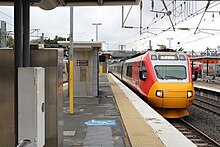Tilt Train
 Diesel Tilt Train in September 2016 | |
| Overview | |
|---|---|
| Service type | Passenger train |
| Current operator(s) | Queensland Rail |
| Route | |
| Termini | Brisbane |
| Line(s) used | North Coast |
| Technical | |
| Rolling stock | |
Tilt Train is the name for two similar high-speed tilting train services, one electric and the other diesel, operated by Queensland Rail. They run on the North Coast line from Brisbane to Rockhampton (electric) and Cairns (diesel). Services commenced in 1998.
The name Tilt Train often refers to the electric train service between Brisbane and Rockhampton only.
History
[edit]Rockhampton
[edit]
Commencing in 1998, the Electric Tilt Train operates from Brisbane to Rockhampton. With a top service speed of 160 km/h (100 mph) and the ability to tilt five degrees in each direction, the Tilt Train is one of the fastest trains in Australia, having a similar maximum allowed speed in revenue service to the V/Line VLocity and the Transwa Prospector railcar, that both run up to 160 km/h, and New South Wales XPT although the XPT is rarely able to achieve its maximum operating speed due to track condition and curvature. The train operates on the North Coast line and serves the intermediate towns of Gympie, Maryborough, Bundaberg and Gladstone. The electric Tilt Trains run in a multiple unit configuration. In May 1999, the tilt train achieved a top speed under test conditions of 210 km/h.[3]
The Electric Tilt Train features 2×2 economy seating, and 1×2 business class seating, mainscreen visual entertainment along with in-seat audio entertainment. Economy class passengers have a regular trolley service and a buffet style galley food service, while business class has a frequent trolley service.[4]
In 2016, Wi-Fi internet access was introduced to the service.[5]
Cairns
[edit]The Diesel Tilt Train, operating from Brisbane to Cairns, features a 2×2 premium economy class seating arrangement, 1×2 business class seating arrangement (Railbed), in-seat audio and visual entertainment and a TV screen attached to the headrest of the seat in front. A trolley service is available in the Railbed carriages, and a club car is available 24 hours. In October 2013, when the first refurbished set returned to traffic, the service was named the Spirit of Queensland.
In 2014, an additional train was delivered to replace The Sunlander between Brisbane and Cairns, meaning the only service on this 1,681 km route since that time has been the Spirit of Queensland.[6][7]
Awards
[edit]In 2009 as part of the Q150 celebrations, the Tilt Train was announced as one of the Q150 Icons of Queensland for its role as an iconic "innovation and invention".[8]
See also
[edit]Notes and references
[edit]- ^ Queensland Rail Travel - Network Map
- ^ Queensland Rail Travel - Timetable (PDF) effective 2 September 2024
- ^ "20th Anniversary of the Tilt Trains". queenslandrail.com.au. 5 November 2018. Archived from the original on 25 April 2023. Retrieved 14 July 2023.
- ^ "Travel Options". Queensland Rail Travel. Archived from the original on 22 March 2023. Retrieved 15 October 2023.
- ^ Probert, Oliver (30 October 2016). "Wi-Fi trial for new look Tilt Train". Rail Express. Archived from the original on 30 March 2018. Retrieved 15 October 2023.
- ^ "Spirit of Queensland". www.queenslandrailtravel.com.au. Archived from the original on 30 September 2016. Retrieved 26 June 2017.
- ^ "Spirit of Queensland" (PDF). Archived (PDF) from the original on 15 June 2017. Retrieved 26 June 2017.
- ^ Bligh, Anna (10 June 2009). "PREMIER UNVEILS QUEENSLAND'S 150 ICONS". Queensland Government. Archived from the original on 24 May 2017. Retrieved 24 May 2017.
